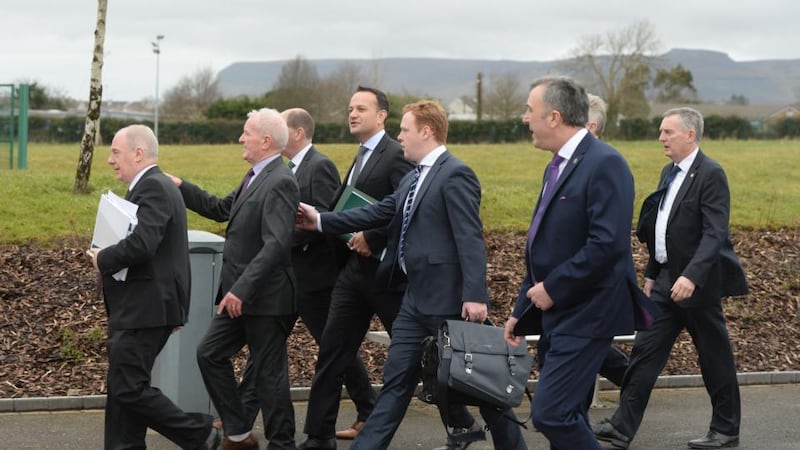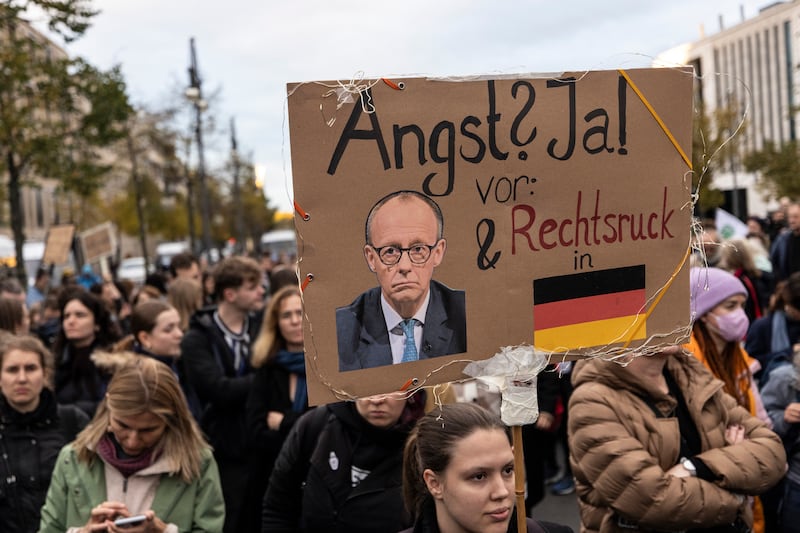John Concannon had to deal with two storms this week. The first was the snowstorm: it’s one of the roles of the strategic-communications unit, at the Department of the Taoiseach, to ensure that the Government puts out a coherent message on big events, whether planned or natural, such as this week’s dangerously bad weather.
The second was what one of his colleagues described as a "sh**storm": the media and public furore Concannon faced over the communication of Project Ireland 2040, the Government's initiative "to make Ireland a better country for all", which takes in the National Development Plan and the National Planning Framework.
Anyone who has met Concannon knows how enthusiastic and positive he can be. His commitment to whatever project is at hand, allied to a lack of cynicism (which might include a little naivety), has resulted in an impressive record. He is a marketing wunderkind, responsible for several stellar successes in recent years: the Gathering Ireland, the Wild Atlantic Way, Ireland 2016 and Creative Ireland. When there have been setbacks – Gabriel Byrne described the Gathering as a "shakedown" – he has bounced back.
But the 43-year-old’s latest incarnation, working at the heart of government, has raised suggestions that he might have bitten off more than he can chew this time. Concannon has hardly been six months in his job as head of the strategic-communications unit, and from the first day he seems to have been fighting a losing battle to define what it does and, as importantly, what it does not do.
The unit is supposed to streamline and focus the communication functions of government. That’s government in the permanent sense, as opposed to the Fine Gael-Independent Coalition that happens to run the show at present. The unit supposedly has no role in day-to-day political controversies. Such firefighting is the responsibility of political or departmental press operations, which are often headed by party appointees.
But it has proved tricky so far to distinguish between the two types of operation. Barely a week goes by when the Opposition does not describe the strategic communications unit as “Leo’s spin unit” or Concannon as Fine Gael’s propagandist in chief.
Brendan Howlin, the Labour Party leader, believes the establishment of the unit was ill advised and predicts Concannon’s plan will backfire spectacularly. The 2016 commemorations were a success because everyone was behind them, Howlin says; that is not the case here, he believes, as the unit favours only the governing party.
Howlin is particularly critical of Project Ireland 2040; he says he cannot recall another government plan being “flogged in cinemas and on bus shelters”. “It’s the notion of taking taxpayers’ hard-earned money and using it to sell a Fine Gael plan replete with Fine Gael faces. It is exactly what you would expect, a national branding exercise, but only branding things that are positive. The bottom line is that the Government and Fine Gael become inextricably the same.”

Howlin is referring in part to claims that, for the launch of Project Ireland 2040, the strategic communications unit sanctioned “paid for” propaganda and “fake news” in national and regional newspapers – puff pieces for the Government’s policy initiative, essentially. The unit has strenuously rejected the accusations.
There are individual voices inside Government who believe the communications function has been elevated out of proportion, and to the detriment of policy issues, leaving the Taoiseach open to attack of over obsession with presentation.
Sources point to Concannon’s leading role this week in coordinating the public side of the Government’s response to the weather emergency. That included the optics of flanking the Taoiseach with senior officers from the Garda and Army when doing a televised press conference and of the Taoiseach’s frequent appearance on radio shows.
“It’s a little over-the-top in my opinion,” says one source.
At the same time Varadkar gave the SCU what amounted to a dressing down over the advertorials on Thursday night, saying Government Secretary General Martin Fraser would carry out a review of the unit.
On the face of it the programme was tailor-made for Concannon’s unit. Here was a big Government project involving many departments and a big plan. And when it happened it bore all the hallmarks of a Concannon operation. On a day when the whole Cabinet decamped to Sligo for the policy announcement, the launch featured two snazzy videos, a social-media ticker, live streaming, PowerPoint presentations and professional staging.
Sure, bits of it came across as artificial. But the whole thing, including an abundance of WB Yeats quotations, prompted my colleague Miriam Lord to call Concannon the PT Barnum of Irish government, and the whole event Pyongyang on the Garavogue.
Advertorials
What snagged the strategic-communications unit happened days later. It involved one of the oldest-fashioned elements of the plan: advertorials, which have been around for half a century. An advertorial is paid-for media content in the form of a report. It's usually clearly described as advertising. In this instance one advertising agency asked that the word not be used. Even so, they were clearly identified in more than 20 regional publications seen by The Irish Times.
(The Irish Times also carried a clearly labelled commercial report on behalf of Project Ireland 2040.)
Against that, there was some evidence that one group of regional newspapers had been asked to make the content appear more “real”. If so, it wasn’t well executed, as the content was of the same obviously paid-for nature as the rest.
There was also a kerfuffle about articles that featured photographs of local Fine Gael candidates, so promoting a particular party at taxpayers’ expense. Some blamed that on the strategic-communications unit.
But only one newspaper, the Longford Leader, featured a Fine Gael candidate, and the paper took that decision entirely by itself. Every regional newspaper used generic copy, and none named any politician, focusing solely on the document. So much for a propaganda campaign.
Causes for concern
That said, there were some causes for concern. The instruction not to use the phrase “advertising” was questionable. Some of the advertorials in national newspapers used interviews with public figures who did not realise they were being used in advertising. There was also the general concern about the blurred boundaries between paid-for and independent journalism.
The unit was not specifically responsible for any of that, but it took the brunt of the criticism. Taoiseach Leo Varadkar accepted on Thursday that the guidelines the unit had issued were too loose and needed to be reviewed.
It was a setback for Concannon, who may be hoping that his knack for bouncing back from PR problems has not deserted him. An 80-second video for the launch of the 1916 centenary project was a disaster, a slick, superficial take on modern Ireland with little or no reference to the Easter Rising.
"We had warned against commercialisation and commodification, and a Gathering Mk II, but this is what this all smacks of," Prof Diarmuid Ferriter, the historian and Irish Times columnist, said at the time. "Take the video . . . It's embarrassing, unhistorical sh**."
Concannon’s response was to organise 80 workshops around the country and come up with a revised plan that put the criticism at naught. Besides the set pieces there were hundreds of events involving ordinary citizens and a huge emphasis on culture, music, theatre, song, language and dance. A televised centenary concert was extraordinary. The idea of donating a Tricolour to every national school also struck a particular chord.
“That is John,” says Cilian Fennell, the broadcasting consultant who produced the centenary show. “He would say, ‘We did it wrong, and we will do it better,’ and he just put the head down. He just gone on with it, learned from his mistakes, until he got it right.”
A former colleague calls him a “fantastically engaging guy, a quintessential marketeer” who is able to “distil everything into a message and then sell that message like mad”. But aren’t marketing and branding an incongruous fit with the public sector? A lot has been made of Concannon’s salary, which is north of €120,000, but others say he could earn far more in the private sector. What motivates him, says Fennell, is a “genuine love for Ireland and a desire to make it a better place. His track record speaks to the public good.”
Concannon went to school at St Jarlath's College in Tuam and afterwards studied commerce and marketing at NUI Galway. He worked for Unilever and Dubarry, the shoe company, before becoming head of Ireland West Tourism at the age of 30. When that was merged into Fáilte Ireland, in 2007, he became marketing director and showed his tougher side by implementing change at the organisation, during which he encountered some fierce resistance.
Holiday at home
He came up with the Discover Ireland idea to encourage Irish people to holiday at home. It featured two recurring themes of Concannon campaigns: adroit use of stunning video and original Irish music (in that instance The Laundry Shop, Heathers and The Riptide Movement). The Gathering, which grew out of the international forum at Farmleigh in 2011, was primarily his idea. It was a huge success, as was the branding of the Wild Atlantic Way.
“He’s an ideas man,” says a former colleague, “and is really good at coming up with the concept. The details he leaves to others.”
Concannon and his wife live in Galway with their three daughters; he commutes to Dublin on predawn buses three days a week. He has been involved with many local voluntary organisations and has chaired Cope Galway, the homelessness, domestic violence, and elderly-support charity, for nine years.
The idea for the strategic-communications unit seems to have been Varadkar’s. He and Concannon shared a view that Ireland was an outlier in Europe because it communicated with citizens in a fragmented way. More than €178 million was spent on communications, but it came from a myriad of departments and agencies, and 220 separate campaigns. In Concannon’s view citizens were not placed at the centre, even though they were entitled to know how their money was spent.
As well as Project Ireland 2040 his unit will be responsible for other big all-of-Government campaigns, such as Healthy Ireland. It also intends to close all the separate departmental websites and bring them under one portal, gov.ie.
Part of the aim is to reduce the number of campaigns to only the most important, such as those on Brexit, the new children's hospital and the two big development plans. The unit has 15 staff at the moment, and a €5 million budget, but those figures will probably grow.
Concannon’s past campaigns involved a single theme or a target. With politics it’s different. The end product is not as tangible. And, no matter how hard he has tried, he cannot avoid being dragged into the political arena. There is a fuzzy divide, after all, between a Government and the politicians who run it.
Noel Toolan is a marketing consultant who has worked on big political projects, including in South Africa. Marketing, as he sees it, is “about logic, almost militarily so. Who is the target? What is our offer? What do we need to do to reach our market? It becomes logistical communications.” What Concannon is doing, he says, “is applying the science of marketing in areas that are nontraditional. It is difficult. But it’s a valid and a good thing to do, because it essentially gives people a clear understanding of what government does.”
That’s the target, but at the moment it’s moving too quickly for Concannon to hit.

















